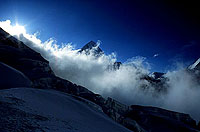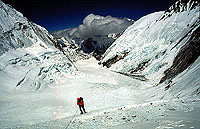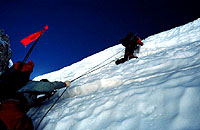 |
 |
 |
 Assault on the Summit
Assault on the Summitpart 4 | back to part 3 Altitude and the Brain: Cerebral Edema The brain uses over 20% of the oxygen we breathe. Not surprisingly, therefore, hypoxia affects the highest functions first—such as judgment. This fact alone might be a contributory factor in some, if not nearly all, of the "accidental deaths" at altitude. Climbers on the highest mountains, especially in the Himalayas, have made mistakes they would never make on smaller peaks. In severe cases, the brain becomes waterlogged and literally swells. Coordination fails, and hallucinations become vivid. This is called High Altitude Cerebral Edema, or HACE, and a climber can die from it unless treatment is immediate.  Hallucinations nonetheless are a regularly experienced phenomenon at high
altitudes. Frank Smythe in 1933 saw strange 'flying objects' above the North
Ridge which his friends jocularly called "Frank's pulsating teapots". Reinhold
Messner, when he climbed the mountain without oxygen, felt he was reduced to a
single gasping lung: "I am nothing more than a single narrow gasping lung,
floating over the mists and the summits." His companion Peter Habler also had
an "out of body" experience, floating above his own shoulder as he watched
himself climbing the upper slopes. The illusion of an extra partner is common
under the physical stresses of high altitude climbing. Brummie Stokes and
Bronco Lane, coming down from the summit, each felt there was a third person on
their rope, and when they brewed tea or shared food they offered some to their
unseen companion. Chris Bonington in 1985 was helped to the summit by the
sense that his father-in-law was steering one arm and his friend Dough Scott
the other. Stephen Venables was encouraged to find himself in a comfortable
country pub with a long-haired girl beside him.
Hallucinations nonetheless are a regularly experienced phenomenon at high
altitudes. Frank Smythe in 1933 saw strange 'flying objects' above the North
Ridge which his friends jocularly called "Frank's pulsating teapots". Reinhold
Messner, when he climbed the mountain without oxygen, felt he was reduced to a
single gasping lung: "I am nothing more than a single narrow gasping lung,
floating over the mists and the summits." His companion Peter Habler also had
an "out of body" experience, floating above his own shoulder as he watched
himself climbing the upper slopes. The illusion of an extra partner is common
under the physical stresses of high altitude climbing. Brummie Stokes and
Bronco Lane, coming down from the summit, each felt there was a third person on
their rope, and when they brewed tea or shared food they offered some to their
unseen companion. Chris Bonington in 1985 was helped to the summit by the
sense that his father-in-law was steering one arm and his friend Dough Scott
the other. Stephen Venables was encouraged to find himself in a comfortable
country pub with a long-haired girl beside him. Yves Malartic, author of Tenzing on Everest, wrote of the severity of
cerebral edema and what happens to a victim before death: "Finally, the
euphoria, hallucinations, and over-excitement
give way to lassitude. At first it becomes impossible for a man to... think
and to draw conclusions. His ideas float away, vanish like clouds, and the man
is unable to fix his attention on anything. He struggles against the fogginess
of his mind, as he struggles against the wind from Everest; he makes every
effort to cling to the guide lines, which,
however, elude his grasp....The lassitude gets worse...he continues to
perceive, but he can no longer reason, or if he does, then only to a slight
degree. The impressions that he receives no longer enter his mind. That is
why those who undertake such extraordinary exploits, such superhuman efforts in
the mountains, can for the most part give only uncertain, vague, extremely
terse reports of what they have done. "
Yves Malartic, author of Tenzing on Everest, wrote of the severity of
cerebral edema and what happens to a victim before death: "Finally, the
euphoria, hallucinations, and over-excitement
give way to lassitude. At first it becomes impossible for a man to... think
and to draw conclusions. His ideas float away, vanish like clouds, and the man
is unable to fix his attention on anything. He struggles against the fogginess
of his mind, as he struggles against the wind from Everest; he makes every
effort to cling to the guide lines, which,
however, elude his grasp....The lassitude gets worse...he continues to
perceive, but he can no longer reason, or if he does, then only to a slight
degree. The impressions that he receives no longer enter his mind. That is
why those who undertake such extraordinary exploits, such superhuman efforts in
the mountains, can for the most part give only uncertain, vague, extremely
terse reports of what they have done. "Continue Photos: (1-3) courtesy Robert Schauer. Lost on Everest | High Exposure | Climb | History & Culture | Earth, Wind, & Ice E-mail | Previous Expeditions | Resources | Site Map | Everest Home Editor's Picks | Previous Sites | Join Us/E-mail | TV/Web Schedule About NOVA | Teachers | Site Map | Shop | Jobs | Search | To print PBS Online | NOVA Online | WGBH © | Updated November 2000 |